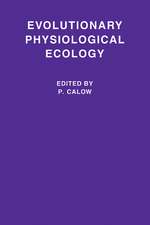Handbook of Biodiversity Methods: Survey, Evaluation and Monitoring
Editat de David Hill, Matthew Fasham, Graham Tucker, Michael Shewry, Philip Shawen Limba Engleză Hardback – 3 aug 2005
Preț: 1140.65 lei
Preț vechi: 1326.34 lei
-14% Nou
Puncte Express: 1711
Preț estimativ în valută:
218.26€ • 227.88$ • 180.64£
218.26€ • 227.88$ • 180.64£
Carte tipărită la comandă
Livrare economică 04-18 aprilie
Preluare comenzi: 021 569.72.76
Specificații
ISBN-13: 9780521823685
ISBN-10: 0521823684
Pagini: 588
Ilustrații: 28 b/w illus. 58 tables
Dimensiuni: 192 x 253 x 31 mm
Greutate: 1.42 kg
Editura: Cambridge University Press
Colecția Cambridge University Press
Locul publicării:Cambridge, United Kingdom
ISBN-10: 0521823684
Pagini: 588
Ilustrații: 28 b/w illus. 58 tables
Dimensiuni: 192 x 253 x 31 mm
Greutate: 1.42 kg
Editura: Cambridge University Press
Colecția Cambridge University Press
Locul publicării:Cambridge, United Kingdom
Cuprins
Preface; Acknowledgements; Part I. Planning M. Fasham, G. Tucker, A. Bennett, T. Rich, M. Shewry, P. Shaw and M. Wade: 1. Introduction to Part 1; 2. Planning a programme; 3. Evaluation methods; Part II. Habitats G. Tucker, M. Fasham, T. Rich, M. Rebane, G. Peterken, F. McMeechan and R. Birnie: 4. Introduction to Part 2; 5. Habitat requirements and issues; 6. Methods for surveying habitats; 7. Surveying and monitoring management or environmental impacts; 8. Habitat conservation evaluation criteria; Part III. Species: 9. Introduction to Part 3; 10. General principles and methods for species M. Fasham and S. Mustoe; 11. Fungi R. Watling, M. Fasham and D. Dobson; 12. Lichens S. Davey, M. Fasham and D. Dobson; 13. Bryophytes G. Rothero, D. Dobson and M. Fasham; 14. Aquatic macrophytes and algae N. Stewart and M. Wade; 15. Vascular plants T. Rich, V. Hack and F. McMeechan; 16. Dragonflies and damselflies C. Plant, R. Sands and M. Fasham; 17. Butterflies C. Plant, R. Sands and M. Fasham; 18. Macromoths C. Plant, R. Sands and M. Fasham; 19. Other terrestrial invertebrates P. Dennis, C. Plant, R. Sands and M. Fasham; 20. Aquatic invertebrates P. Kerrison, T. Norman and M. Fasham; 21. Fish N. Giles, R. Sands and M. Fasham; 22. Amphibians D. Latham, E. Jones and M. Fasham; 23. Reptiles D. Latham, E. Jones and M. Fasham; 24. Birds S. Mustoe, D. Hill, D. Frost and G. Tucker; 25. Bats R. Stebbings, H. Mansfield and M. Fasham; 26. Other mammals A. Bennett, P. Ratcliffe, E. Jones, H. Mansfield and R. Sands; Acknowledgements; Glossary, Appendices; Recommended sources of further information; References; Index.
Recenzii
'Many consultants and project students should find it very helpful.' Ibis
'The Handbook draws together much material that has usually been scattered in the literature. … Numerous approaches to biodiversity evaluation are described and discussed in its pages and a practical focus is maintained throughout.' Biologist
'… impressive … Extremely helpful …' Basic and Applied Ecology
'When I opened it and started to flick through it I found that I was drawn into reading section after section. … well written and covers each separate subject concisely … It is difficult to find fault with this publication … in time this handbook will become the standard text for biodiversity monitoring and will grace the shelves of consultants, wildlife professionals and conservation workers alike.' BRISC Recorder News
'… a valuable reference for anyone involved in the many biodiversity audits … well set out and easy to read … useful diagrams … The authors and editors of this handbook are all experienced field ecologists and highly respected authorities …' In Practice
'The Handbook draws together much material that has usually been scattered in the literature. … Numerous approaches to biodiversity evaluation are described and discussed in its pages and a practical focus is maintained throughout.' Biologist
'… impressive … Extremely helpful …' Basic and Applied Ecology
'When I opened it and started to flick through it I found that I was drawn into reading section after section. … well written and covers each separate subject concisely … It is difficult to find fault with this publication … in time this handbook will become the standard text for biodiversity monitoring and will grace the shelves of consultants, wildlife professionals and conservation workers alike.' BRISC Recorder News
'… a valuable reference for anyone involved in the many biodiversity audits … well set out and easy to read … useful diagrams … The authors and editors of this handbook are all experienced field ecologists and highly respected authorities …' In Practice
Notă biografică
David Hill is a distinguished New Zealand writer, best known for his award-winning novels for young people, which have been translated into several languages. Born in Napier, New Zealand, David studied at Victoria University of Wellington and became a high-school teacher, taking up writing full-time in 1982.
David has published more than 40 titles over the past three decades, winning many awards.
In 2004 David was made a Member of the New Zealand Order of Merit and in 2005 he was awarded the Storylines Margaret Mahy Medal, acknowledging his significant contribution to children's literature in New Zealand.
Descriere
This Handbook, first published in 2005, provides standard procedures for planning and conducting a survey of any species or habitat and for evaluating the data.
















